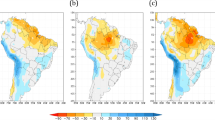Abstract.
An asynchronously coupled global atmosphere-biome model is used to assess the dynamics of deserts and drought in the Sahel, Saudi-Arabia and the Indian subcontinent. Under present-day conditions of solar irradiation and sea-surface temperatures, the model finds two solutions: the first solution yields the present-day distribution of vegetation and deserts and the second shows a northward spread of savanna and xerophytic shrub of some 600 km, particularly in the southwest Sahara. Comparison of atmospheric states associated with these solutions corroborates Charney’s theory of a self-induction of deserts through albedo enhancement in the Sahel. Over the Indian subcontinent, changes in vegetation are mainly caused by a positive feedback between increased soil moisture and stronger summer monsoon.
Similar content being viewed by others
Author information
Authors and Affiliations
Additional information
Received: 18 April 1995/Accepted: 17 September 1996
Rights and permissions
About this article
Cite this article
Claussen, M. Modeling bio-geophysical feedback in the African and Indian monsoon region. Climate Dynamics 13, 247–257 (1997). https://doi.org/10.1007/s003820050164
Issue Date:
DOI: https://doi.org/10.1007/s003820050164




